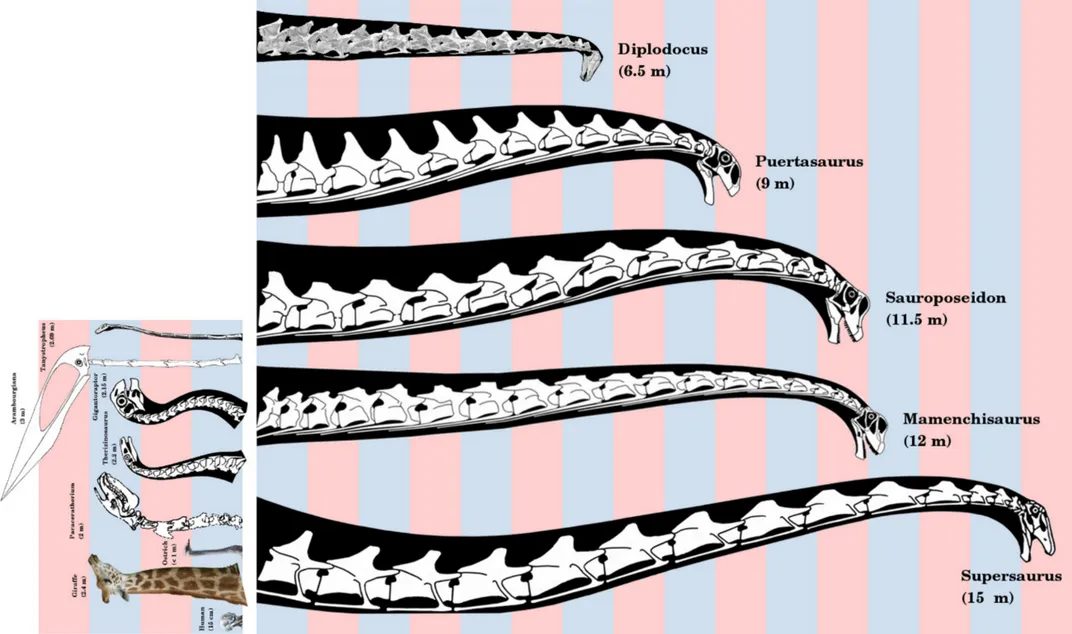How Long-Necked Dinosaurs Pumped Blood to Their Brains
Well-preserved fossils include spring-like neck bones that may have helped the giants get blood from their hearts to their heads
:focal(237x150:238x151)/https://tf-cmsv2-smithsonianmag-media.s3.amazonaws.com/filer/f0/68/f068f008-0c31-4faa-8370-7a83701b2dd2/diplodocus.jpg)
Living large isn’t easy. The sauropod dinosaurs—the biggest creatures to ever walk the Earth—required rapid growth rates, skeletons that were both light and strong and copious amounts of food, just for starters.
Now, paleontologists may have cracked one of the remaining mysteries about these giant dinosaurs: How did they pump enough blood up their long necks to feed their brains?
University of Southern California paleontologist Michael Habib was inspired to investigate sauropod necks after seeing bones from a giant titanosaur found in the New Mexico desert. The well-preserved neck bones included spines called cervical ribs that stretch almost six feet long. These rods, Habib says, turned out to be made of a very flexible sort of bone that “made pretty darn good springs.”
As the giant dinosaurs walked, the motion would have created an “inertial problem” for the sauropods. Without something to dampen this effect, Habib says, “the neck is going to start to sway back and forth like a badly mounted crane or tree in a breeze.”
This is where the cervical ribs came in. These springy bones dampened that effect, allowing the dinosaurs to keep their necks relatively steady as they plodded along, Habib told researchers gathered last week at the Society of Vertebrate Paleontology meeting in Dallas, Texas.
But Habib found that the dinosaurs’ special anatomical arrangement had a peculiar side effect. From a combination of fossil and modern animal anatomy, paleontologists know which muscles must have surrounded the cervical ribs and the other nearby soft tissues. In sauropods, as the cervical ribs flexed, they would have compressed towards the neck, and the muscle would have pushed on air sacs wrapped around the vertebral artery. In effect, the motion “acts as an accessory pump to the heart,” says Habib.

Paleontologists have been debating for decades how sauropods could have generated enough blood pressure to pump the vital fluid from the heart to the brain.
“Sauropod necks are contentious for the same reason as other parts of dinosaur anatomy are contentious—it’s an extreme trait,” Habib says. Researchers have proposed two-ton hearts, special siphon systems and even a string of little “pseudo-hearts” to overcome the problem, but all these ideas suffered from the fact that the relevant soft tissues were never preserved.
According to Habib’s hypothesis, the answer has been staring us in the face all along. And the solution would have worked with relatively little effort. Blood pumping would get a boost any time the dinosaurs moved their necks, Habib says, and the effect only gets stronger in dinosaurs with extraordinarily long necks.
“As you make the neck longer, you get more skeletal muscle and get more pump”, Habib says, meaning that extreme sauropods like Mamenchisaurus, which had a neck that stretched nearly 40 feet, would have had plenty of extra power to keep their blood pumping.
If even one to three percent of the neck’s muscle power helped blood flow, the effect would have reduced the required mass of the heart by over 25 percent, Habib notes. So the neck doing even a little work would have been a great relief to the heart. In this case, sauropods didn’t require special, unseen organs to keep their blood pumping. Instead, the arrangement of muscles, blood vessels and air sacs, Habib says, meant that “the neck pays for itself.”
/https://tf-cmsv2-smithsonianmag-media.s3.amazonaws.com/accounts/headshot/RileyBlack.png)
/https://tf-cmsv2-smithsonianmag-media.s3.amazonaws.com/accounts/headshot/RileyBlack.png)